Research on the Hydrodynamic Performance of a Horizontal-Axis Tidal Current Turbine with Symmetrical Airfoil Blades Based on Swept-Back Models
Abstract
1. Introduction
2. Backward Swept Blade Design
2.1. Initial Model
2.2. Swept Model
2.3. 3D Model
3. Numerical Simulation
3.1. Meshing
3.2. Mesh Independence Analysis
3.3. Calculation and Post-Processing
4. Analysis of Simulation Results
4.1. Starting Torque
4.2. Energy Efficiency Analysis
4.3. Load Analysis
5. Experimental Verification
6. Conclusions
Author Contributions
Funding
Institutional Review Board Statement
Informed Consent Statement
Data Availability Statement
Conflicts of Interest
References
- Zhang, D.; Wang, J.; Lin, Y.; Si, Y.; Huang, C.; Yang, J.; Huang, B.; Li, W. Present situation and future prospect of renewable energy in China. Renew. Sustain. Energy Rev. 2017, 76, 865–871. [Google Scholar] [CrossRef]
- Melikoglu, M. Current status and future of ocean energy sources: A global review. Ocean. Eng. 2018, 148, 563–573. [Google Scholar] [CrossRef]
- Lewis, M.; McNaughton, J.; Marquez-Dominguez, C.; Todeschini, G.; Togneri, M.; Masters, I.; Allmark, M.; Stallard, T.; Neill, S.; Goward-Brown, A.; et al. Power variability of tidal-stream energy and implications for electricity supply. Energy 2019, 183, 1061–1074. [Google Scholar] [CrossRef]
- Payne, G.S.; Stallard, T.; Martinez, R. Design and manufacture of a bed supported tidal turbine model for blade and shaft load measurement in turbulent flow and waves. Renew. Energy 2017, 107, 312–326. [Google Scholar] [CrossRef]
- Dong, Y.; Guo, J.; Chen, J.; Sun, C.; Zhu, W.; Chen, L.; Zhang, X. Development of a 300 kW horizontal-axis tidal stream energy conversion system with adaptive variable-pitch turbine and direct-drive PMSG. Energy 2021, 226, 120361. [Google Scholar] [CrossRef]
- Kaya, M.N.; Kose, F.; Ingham, D.; Ma, L.; Pourkashanian, M. Aerodynamic performance of a horizontal axis wind turbine with forward and backward swept blades. J. Wind. Eng. Ind. Aerodyn. 2018, 176, 166–173. [Google Scholar] [CrossRef]
- Hansen, M. Aeroelastic Properties of Backward Swept Blades. In Proceedings of the Aiaa Aerospace Sciences Meeting Including the New Horizons Forum & Aerospace Exposition, Fort Worth, TX, USA, 7–10 January 2013. [Google Scholar]
- Larwood, S.; Dam, C.V.; Schow, D. Design studies of swept wind turbine blades. Renew. Energy 2014, 71, 563–571. [Google Scholar] [CrossRef]
- Chen, J.; Shen, X.; Zhu, X.; Du, Z. Study on Capability of Backward Swept Blades to Mitigate Loads of Wind Turbine in Shear Flow. J. Energy Resour. Technol. 2019, 141, 081201.081201–081201.081211. [Google Scholar] [CrossRef]
- Khalafallah, M.G.; Ahmed, A.M.; Emam, M.K. CFD study of some factors affecting performance of HAWT with swept blades. Int. J. Sustain. Energy 2017, 36, 489–501. [Google Scholar] [CrossRef]
- Amano, R.; Avdeev, I.; Malloy, R.; Shams, M.Z. Power, structural and noise performance tests on different wind turbine rotor blade designs. Int. J. Sustain. Energy 2013, 32, 78–95. [Google Scholar] [CrossRef]
- Verelst, D.R.; Larsen, T.J. Load Consequences when Sweeping Blades—A Case Study of a 5 MW Pitch Controlled Wind Turbine; Risø-R-Report Risø-R-1724(EN); Risø DTU National Laboratory for Sustainable Energy: Roskilde, Denmark, 2010. [Google Scholar]
- Chen, J.; Wu, B.; Zhu, W.; Xu, M.; Dong, Y.; Zhang, X. Design and Research of Passive Adaptive Bidirectional Flow Blade for Horizontalaxis Tidal Current Energy. Acta Energ. Sol. Sin. 2018, 39, 3295–3301. [Google Scholar]
- Wang, S.; Chen, C.; Tan, J.; Yuan, P.; Zhou, X. Hydrodynamic performance of horizontal axis tidal current turbine based on blade element momentum theory. Acta Energ. Sol. Sin. 2014, 35, 599–604. [Google Scholar]
- Edmunds, M.; Williams, A.J.; Masters, I.; Croft, T.N. An enhanced disk averaged CFD model for the simulation of horizontal axis tidal turbines. Renew. Energy 2017, 101, 67–81. [Google Scholar] [CrossRef]
- Ma, S.; Li, W.; Liu, H.; Lin, Y. Research on the Energy Capture Device of Horizontal Axis Tidal Current Energy Conversion Systems. Chin. J. Mech. Eng. 2010, 46, 150–156. [Google Scholar] [CrossRef]
- Lan, Y.; Zhang, T.; Wang, S.; Song, Q.; Rao, Y. Structure Design and Hydrodynamic Performance Analysis of Tidal Current Turbine Blades. Ship Eng. 2021, 43, 140–144. [Google Scholar]
- Li, D.; Zheng, Y.; Zhang, Y. Blade design of tidal current turbines using blade element theory. J. Hydroelectr. Eng. 2017, 36, 113–120. [Google Scholar]
- Badshah, M.; Badshah, S.; Kadir, K. Fluid Structure Interaction Modelling of Tidal Turbine Performance and Structural Loads in a Velocity Shear Environment. Energies 2018, 11, 1837. [Google Scholar] [CrossRef]
- Kulkarni, S.S.; Chapman, C.; Shah, H. Computational Fluid Dynamics (CFD) Mesh Independency Study of A Straight Blade Horizontal Axis Tidal Turbine. Preprints 2016, 2016080008. [Google Scholar] [CrossRef]
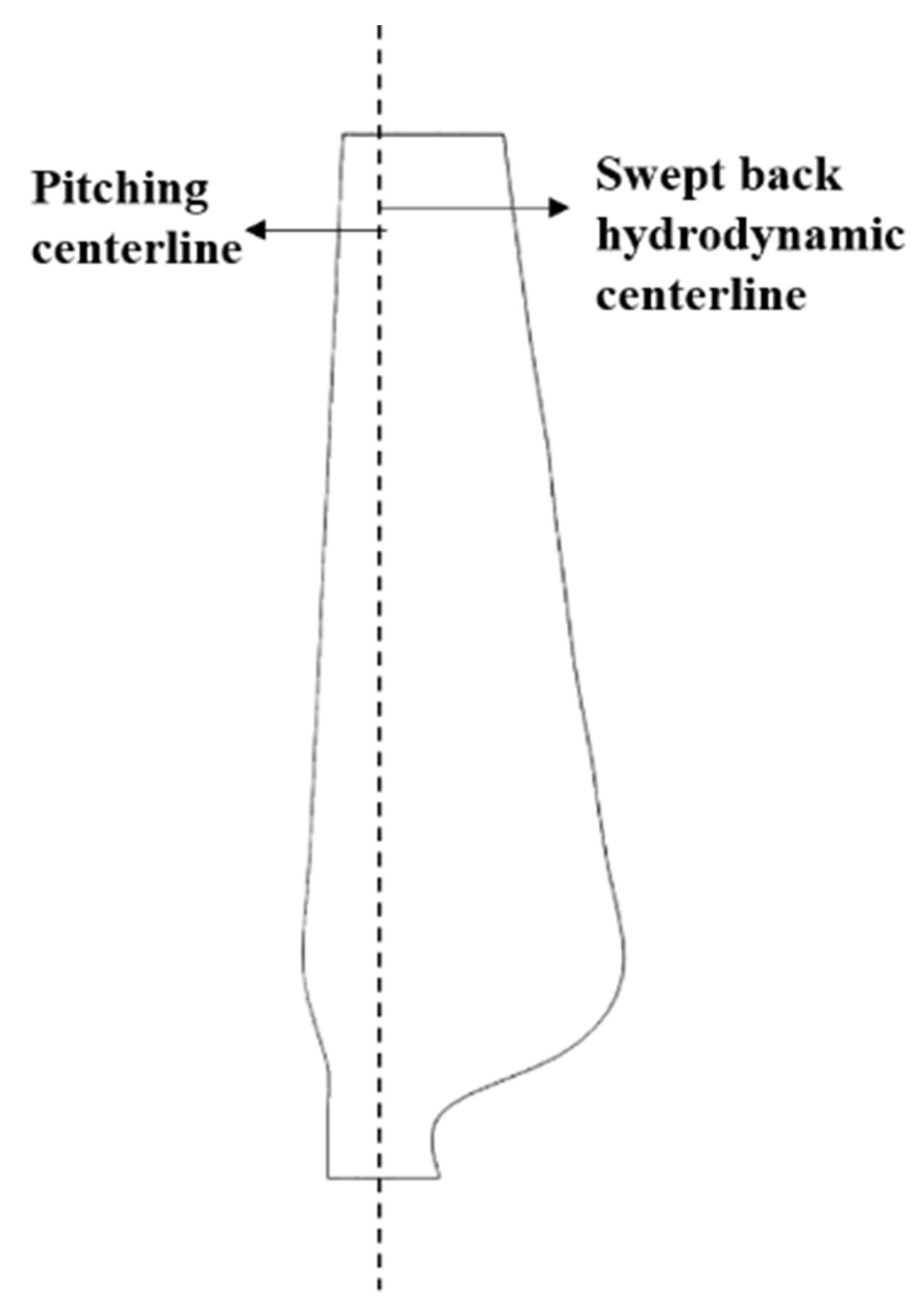
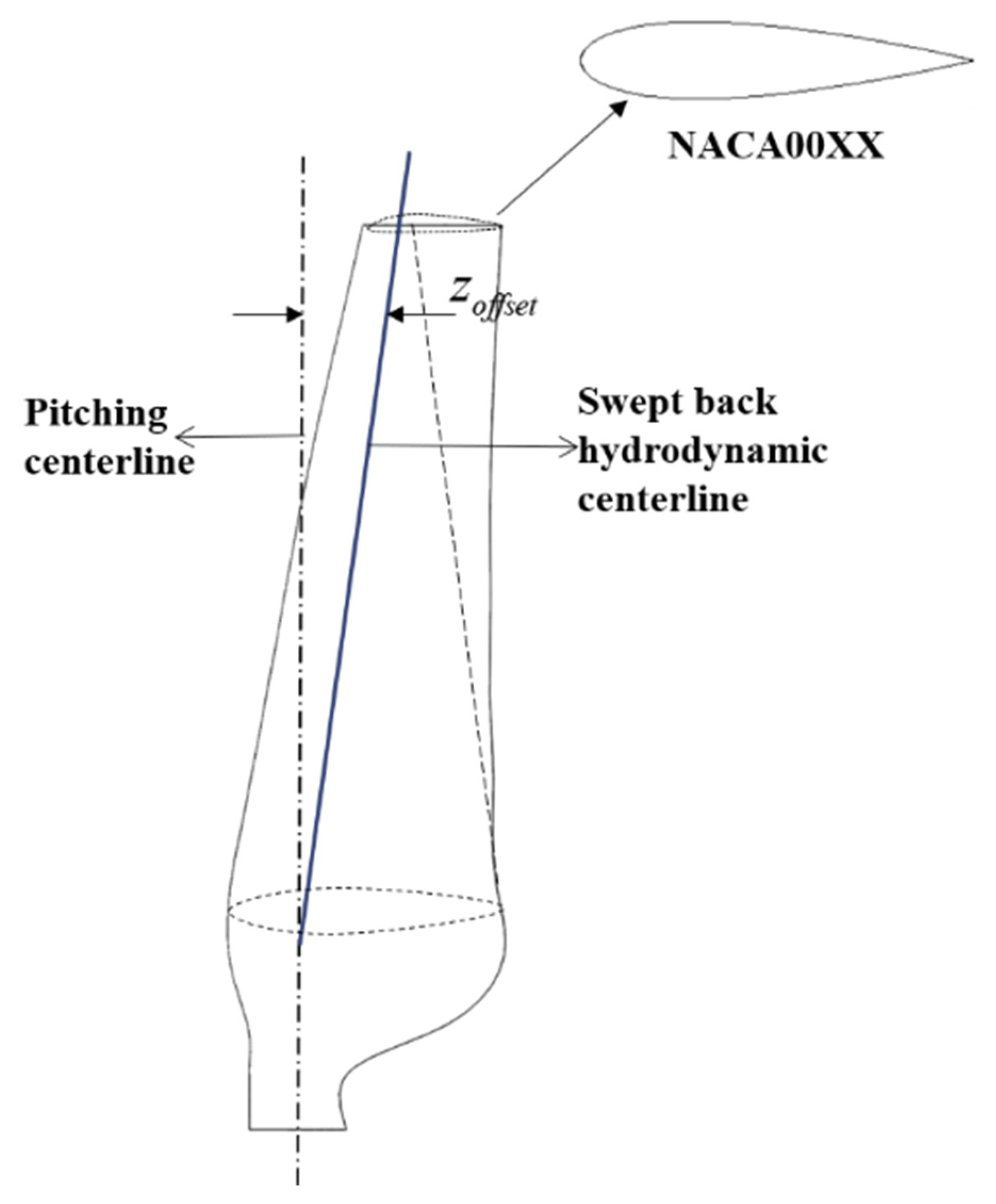
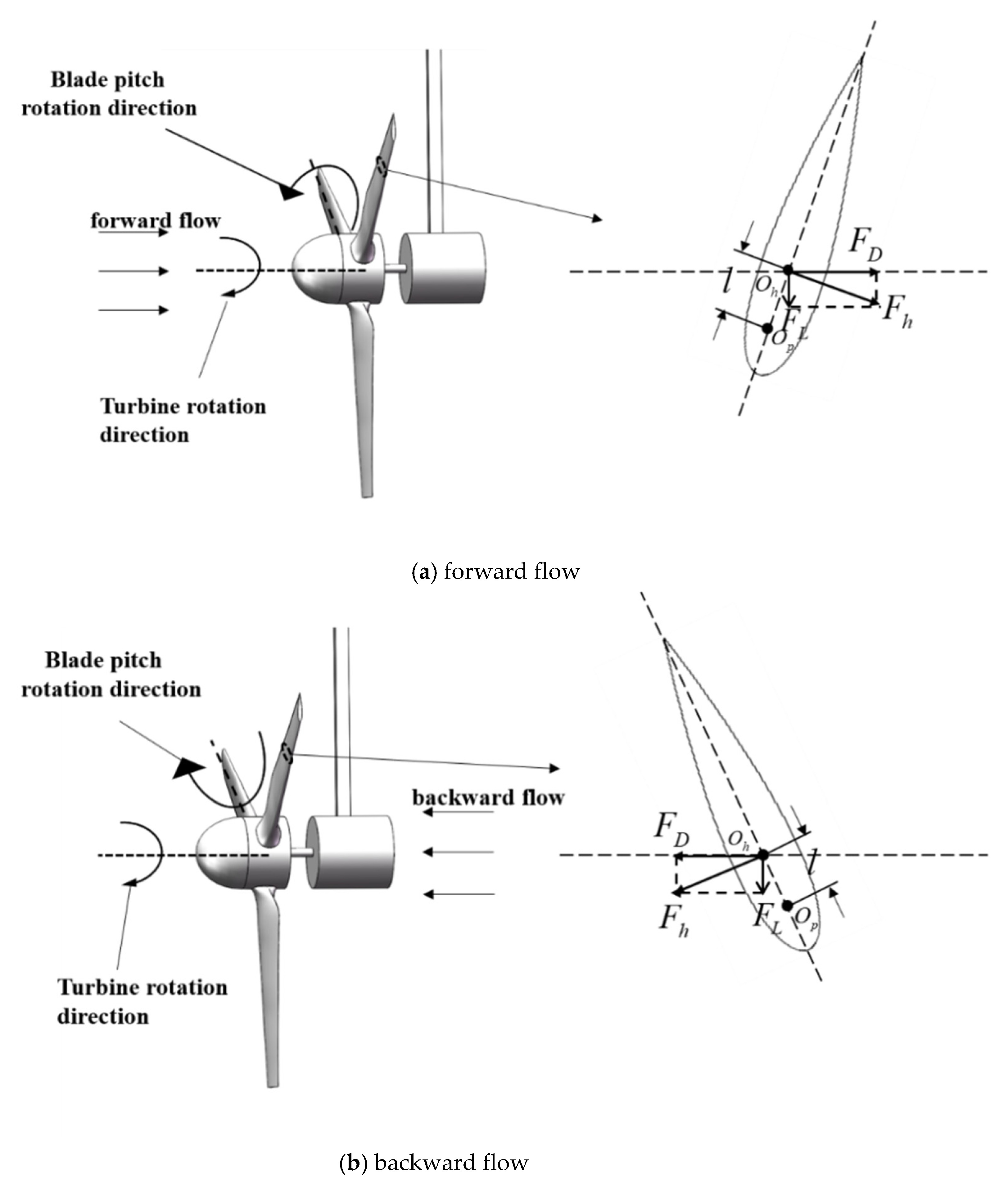


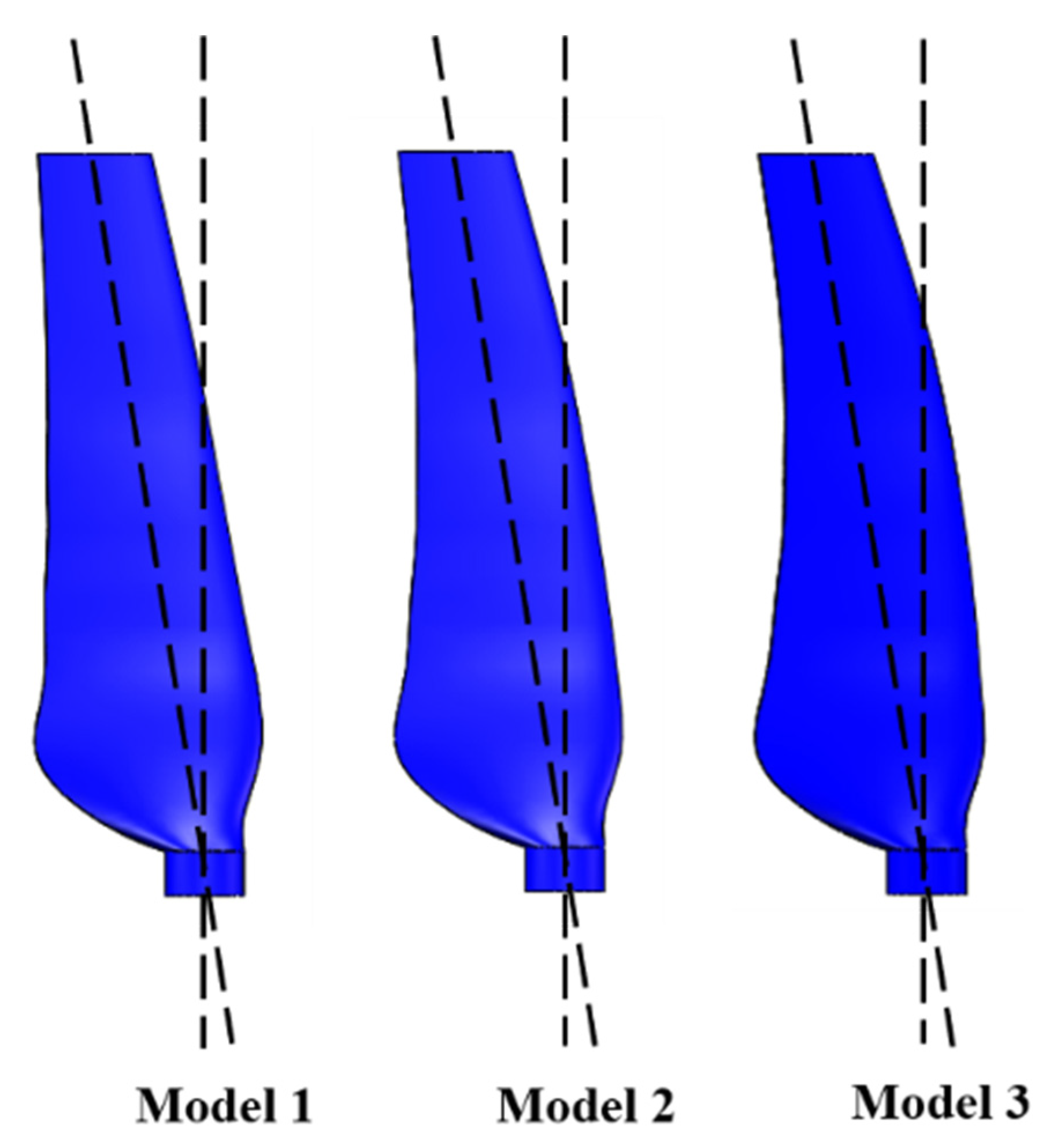

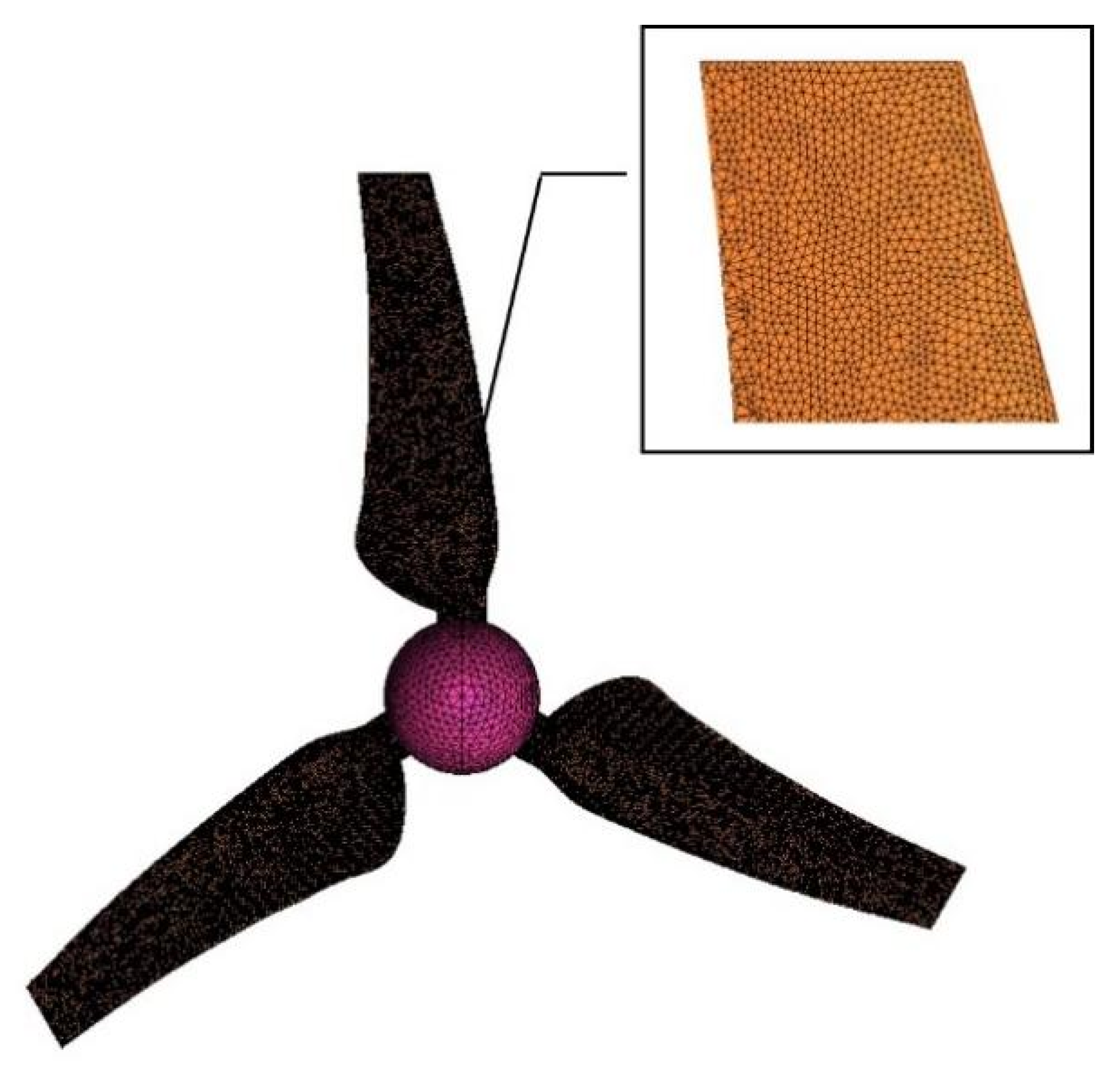
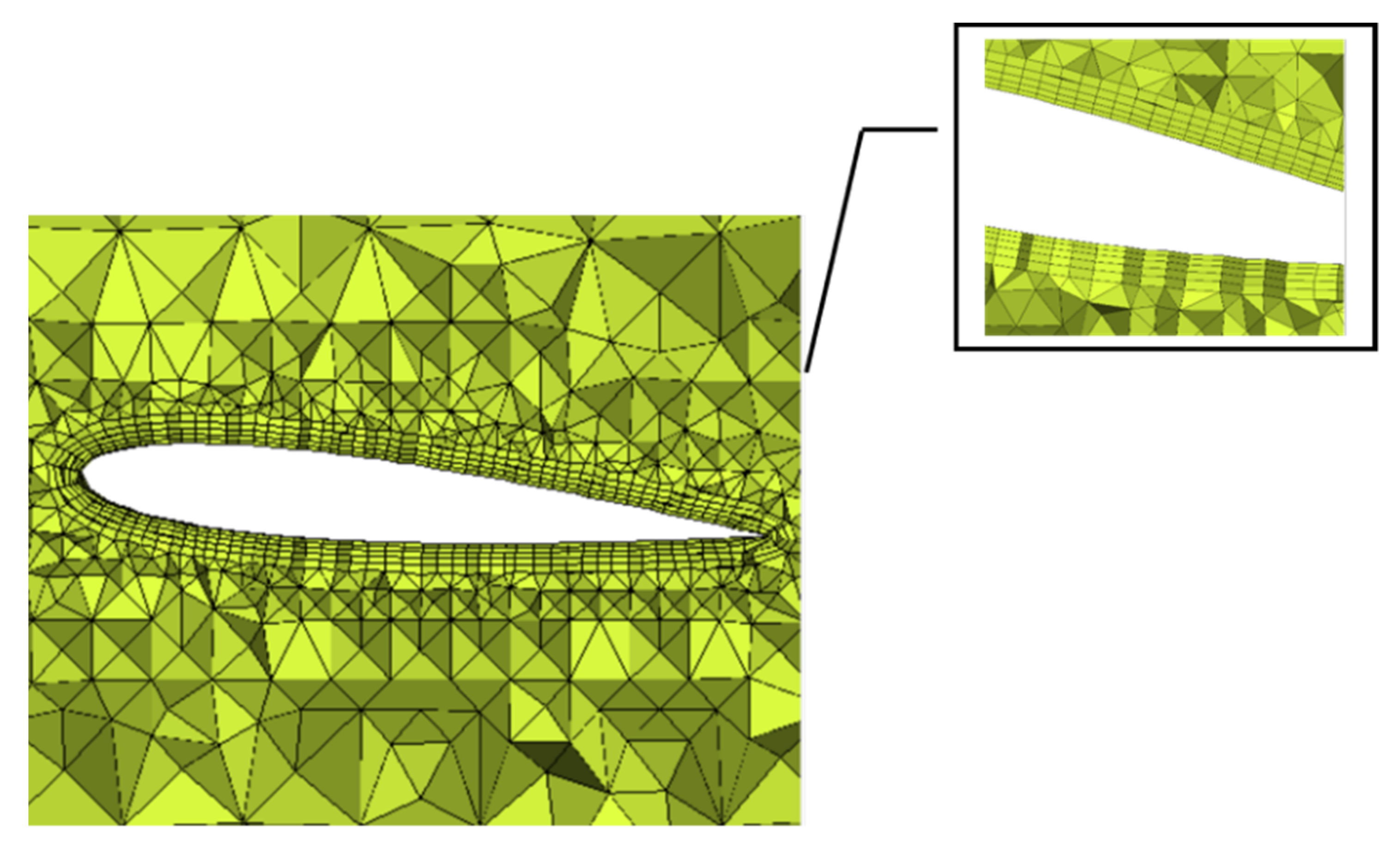

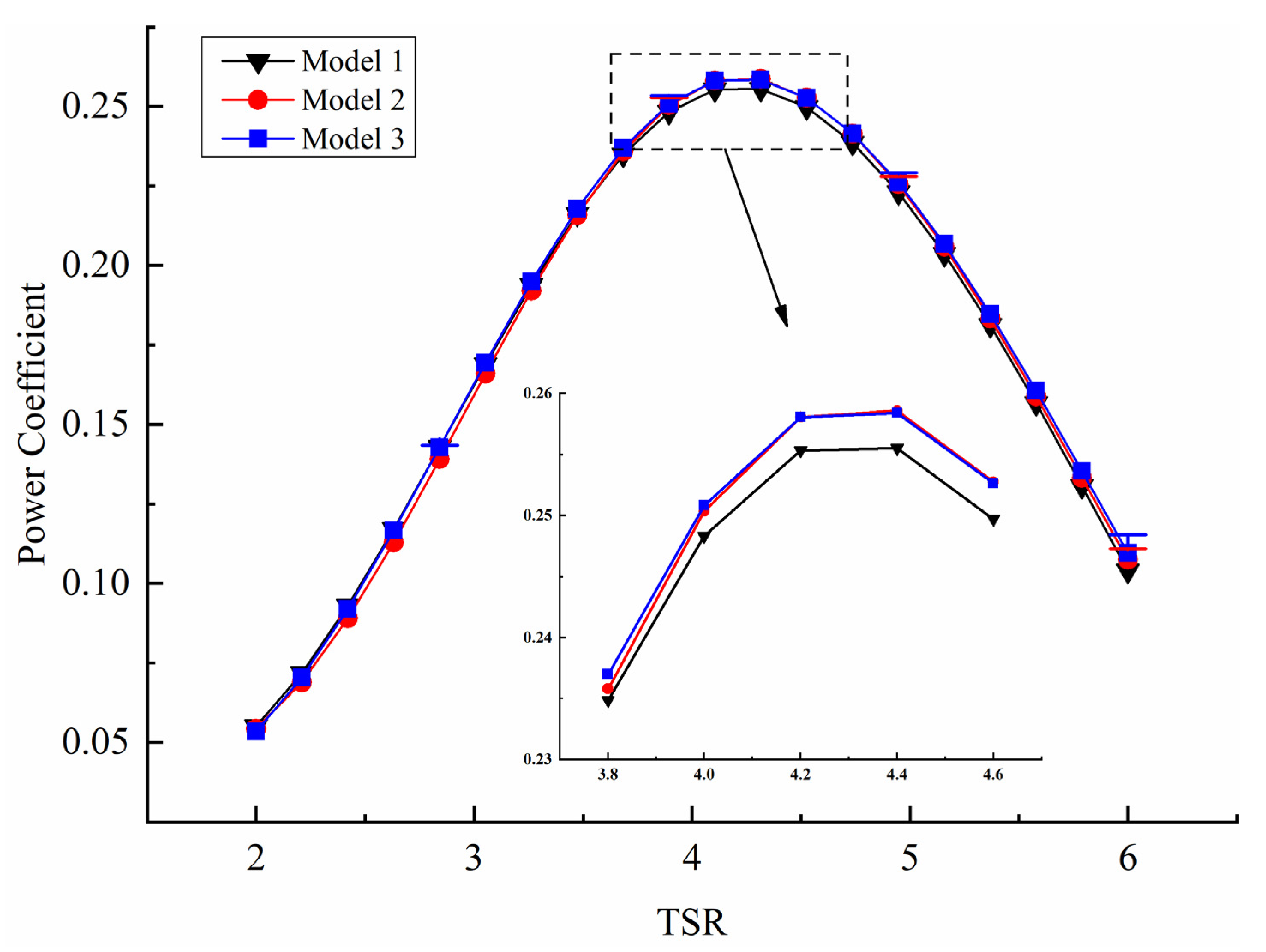
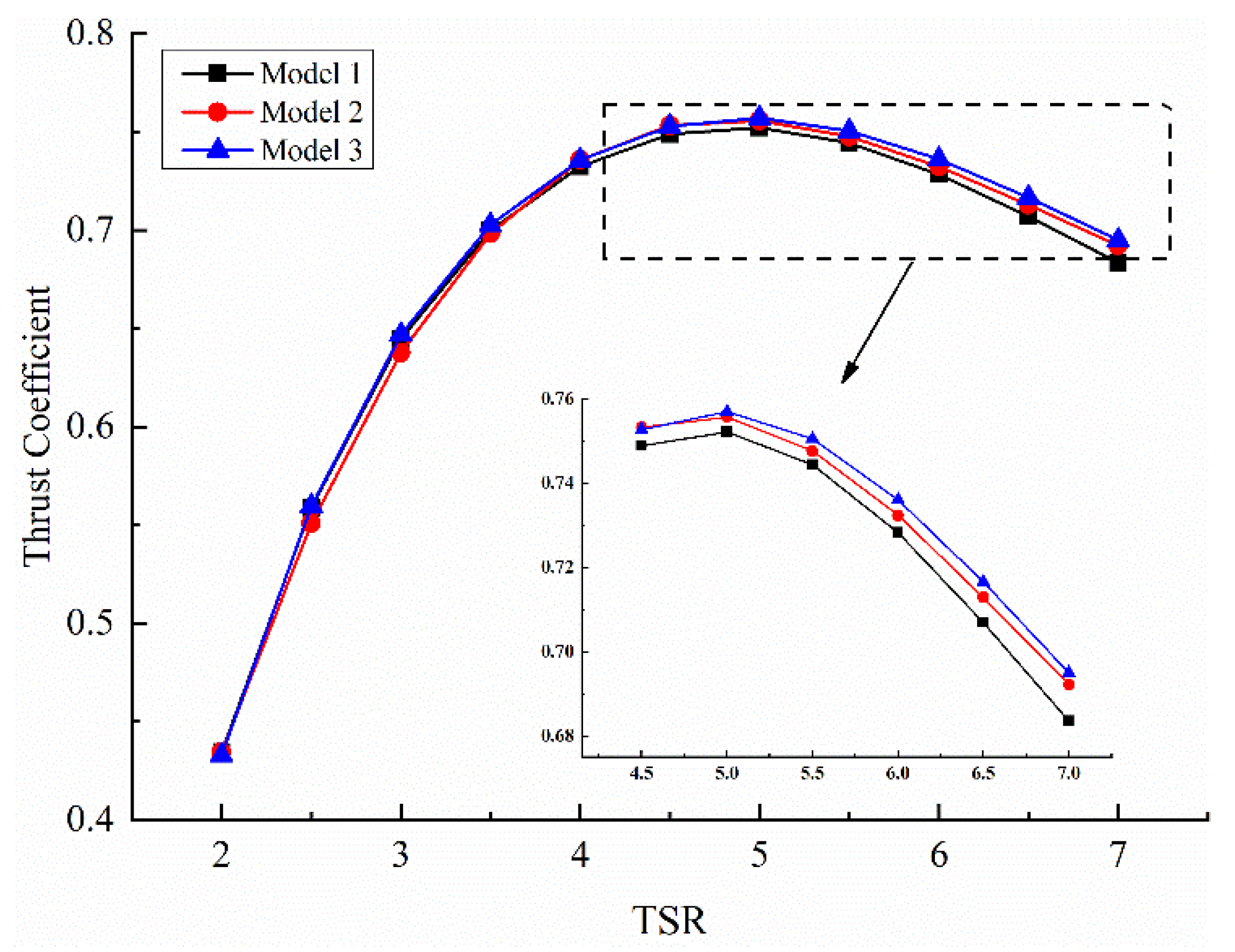

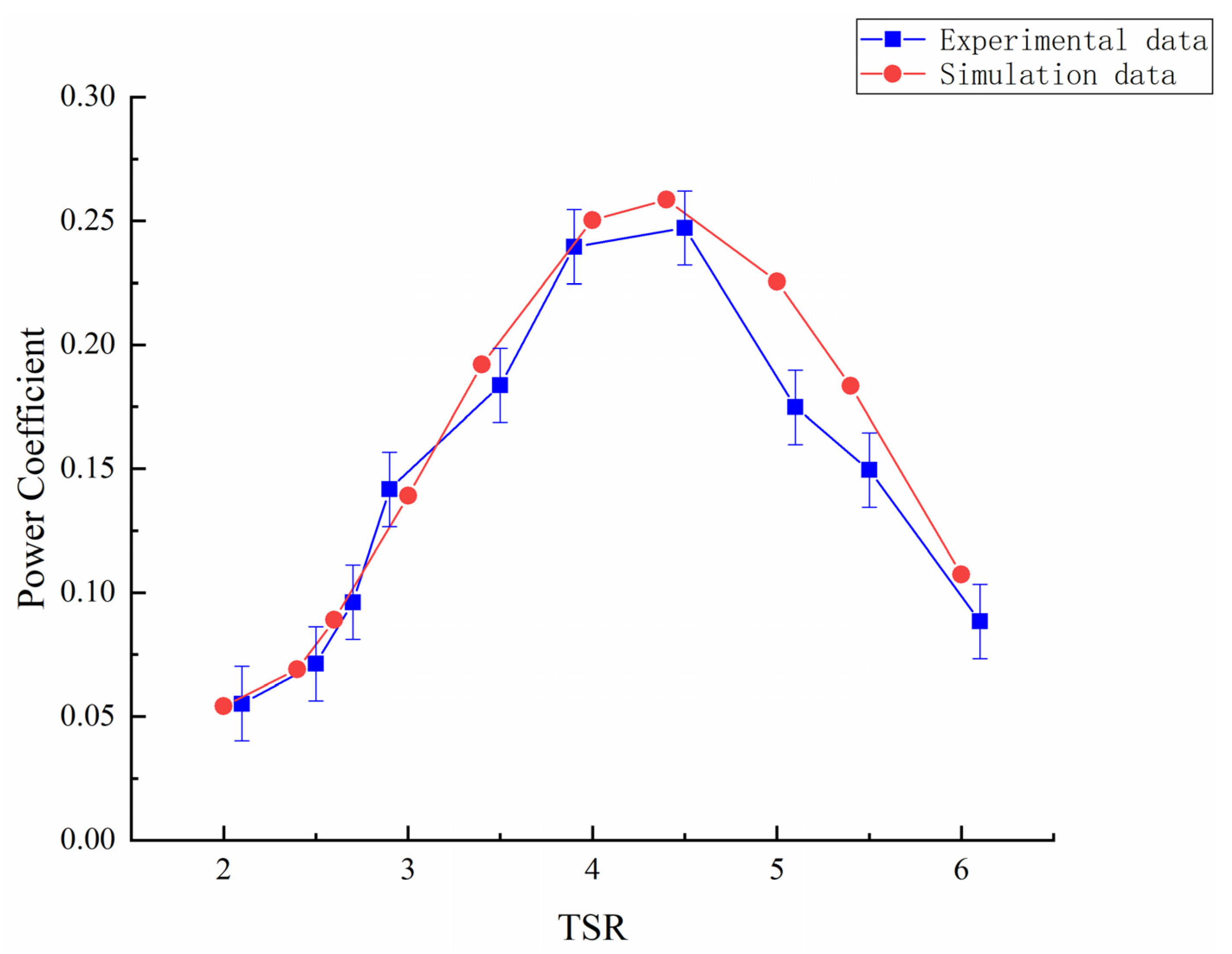
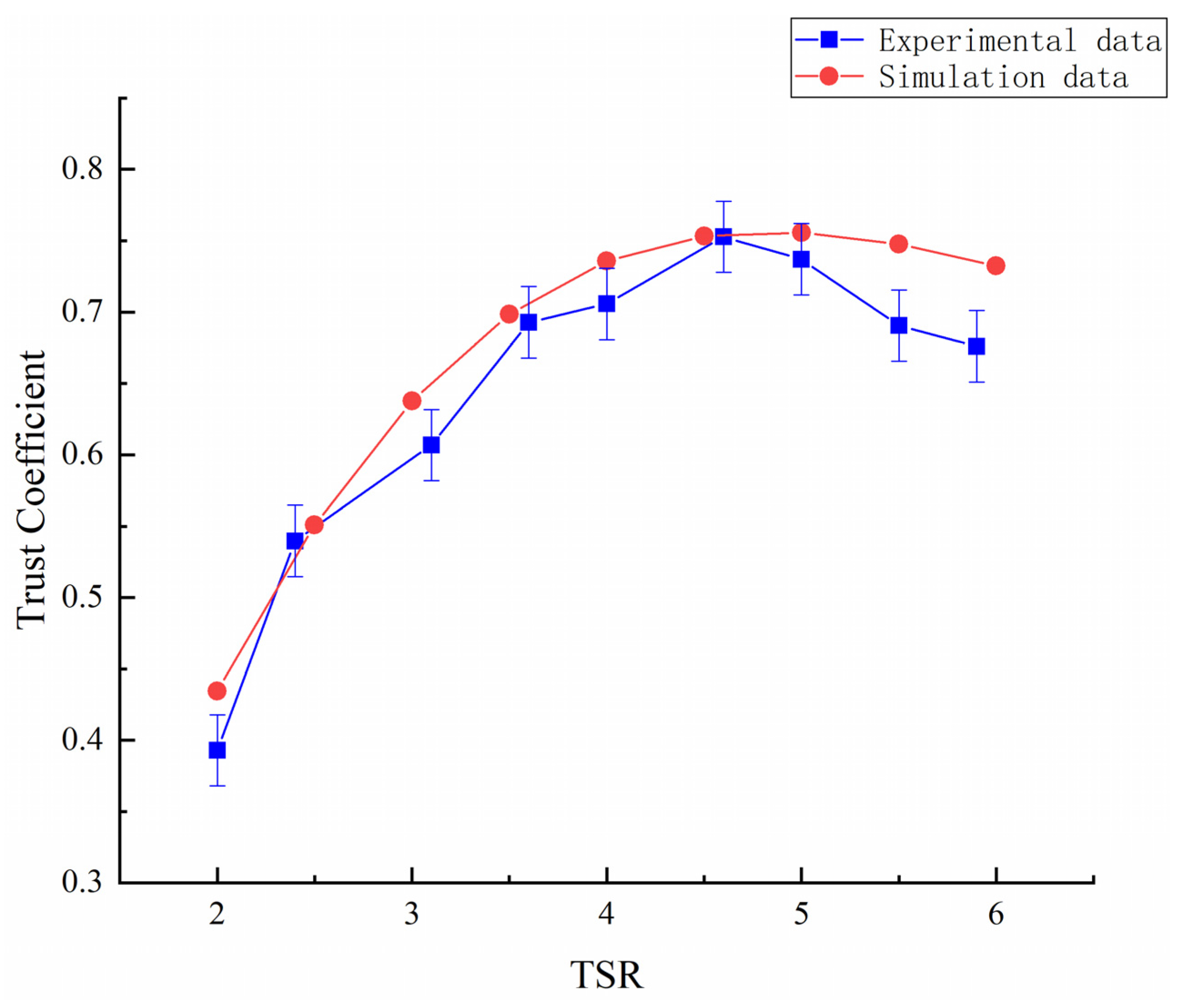
| Spanwise Position (r/R) | Radius r/mm | Chord Length c/mm | Airfoils |
|---|---|---|---|
| 0.09 | 14.94 | − | − |
| 0.15 | 24.90 | − | circle with radius 10 |
| 0.20 | 33.20 | 33.44 | NACA0030 |
| 0.27 | 44.82 | 45.54 | NACA0018 |
| 0.35 | 58.10 | 43.51 | NACA0018 |
| 0.40 | 66.40 | 41.49 | NACA0015 |
| 0.47 | 78.02 | 39.46 | NACA0015 |
| 0.53 | 87.98 | 37.44 | NACA0015 |
| 0.60 | 99.60 | 35.42 | NACA0015 |
| 0.66 | 109.56 | 33.39 | NACA0015 |
| 0.73 | 121.18 | 31.37 | NACA0012 |
| 0.79 | 131.14 | 29.34 | NACA0012 |
| 0.86 | 142.76 | 27.32 | NACA0012 |
| 0.93 | 154.38 | 25.30 | NACA0012 |
| 1 | 166.00 | 23.32 | NACA0012 |
| Model Type | Offset Equation |
|---|---|
| 1 | (Kaya 2018) |
| 2 | (Hansen 2011) |
| 3 | (Larwood 2014) |
| Spanwise Position (r/R) | Offset/mm | ||
|---|---|---|---|
| Model 1 | Model 2 | Model 3 | |
| 0.09 | 0 | 0 | 0 |
| 0.15 | 0 | 0 | 0 |
| 0.20 | 0 | 0 | 0 |
| 0.27 | 0 | 0 | 0 |
| 0.35 | 0 | 0.00100 | 0 |
| 0.40 | 0.649622 | 0.50880 | 0.0982 |
| 0.47 | 1.843385 | 1.43280 | 0.5657 |
| 0.53 | 3.082826 | 2.42280 | 1.2729 |
| 0.60 | 4.728119 | 3.80880 | 2.4556 |
| 0.66 | 6.277070 | 5.19470 | 3.7757 |
| 0.73 | 8.214997 | 7.04260 | 5.6734 |
| 0.79 | 9.968596 | 8.82440 | 7.6065 |
| 0.86 | 12.10352 | 11.1342 | 10.2193 |
| 0.93 | 14.31841 | 13.6927 | 13.2171 |
| 1 | 16.60000 | 16.6000 | 16.6000 |
| Scheme | Number of Nodes | Total Number of Grids | Power Coefficient |
|---|---|---|---|
| 1 | 497,198 | 2,068,095 | 0.2527 |
| 2 | 659,907 | 3,060,727 | 0.2537 |
| 3 | 889,314 | 4,972,207 | 0.2486 |
| 4 | 1,000,141 | 5,035,295 | 0.2898 |
| 5 | 1,639,727 | 7,848,863 | 0.2899 |
| Velocity(m/s) | Starting Torque/N.m | ||
|---|---|---|---|
| Model 1 | Model 2 | Model 3 | |
| 0.2 | 0.0055851 | 0.0056708 (+1.53%) | 0.0055949 (+0.18%) |
| 0.3 | 0.0126293 | 0.0126649 (+0.28%) | 0.0126492 (+0.16%) |
| 0.4 | 0.0225441 | 0.0226049 (+0.27%) | 0.0225837 (+0.18%) |
| 0.5 | 0.0353502 | 0.0354231 (+0.21%) | 0.0354115 (+0.17%) |
| TSR | Power Coefficient | ||
|---|---|---|---|
| Model 1 | Model 2 | Model 3 | |
| 2 | 0.05498 | 0.05424 (−1.35%) | 0.05341 (−2.86%) |
| 3 | 0.16236 | 0.15923 (−1.93%) | 0.16284 (+0.3%) |
| 4 | 0.2527 | 0.25514 (+0.96%) | 0.25534 (+1.00%) |
| 5 | 0.21838 | 0.22091 (+1.20%) | 0.22151 (+1.40%) |
| 6 | 0.10393 | 0.10739 (+3.22%) | 0.1096 (+5.17%) |
| TSR | Thrust Coefficient | ||
|---|---|---|---|
| Model 1 | Model 2 | Model 3 | |
| 2 | 0.43441 | 0.43453 (+0.03%) | 0.43299 (−0.33%) |
| 3 | 0.64484 | 0.63774 (−1.1%) | 0.64689 (+0.32%) |
| 4 | 0.73239 | 0.73574 (+0.457%) | 0.73575 (+0.459%) |
| 5 | 0.75227 | 0.75575 (+0.46%) | 0.75702 (+0.63%) |
| 6 | 0.72829 | 0.73242 (+0.57%) | 0.73610 (+1.07%) |
| 7 | 0.68359 | 0.69225 (+1.27%) | 0.69507 (+1.68%) |
Publisher’s Note: MDPI stays neutral with regard to jurisdictional claims in published maps and institutional affiliations. |
© 2022 by the authors. Licensee MDPI, Basel, Switzerland. This article is an open access article distributed under the terms and conditions of the Creative Commons Attribution (CC BY) license (https://creativecommons.org/licenses/by/4.0/).
Share and Cite
Yan, Y.-T.; Xu, S.-M.; Liu, C.; Zhang, X.; Chen, J.-M.; Zhang, X.-M.; Dong, Y.-J. Research on the Hydrodynamic Performance of a Horizontal-Axis Tidal Current Turbine with Symmetrical Airfoil Blades Based on Swept-Back Models. J. Mar. Sci. Eng. 2022, 10, 1515. https://doi.org/10.3390/jmse10101515
Yan Y-T, Xu S-M, Liu C, Zhang X, Chen J-M, Zhang X-M, Dong Y-J. Research on the Hydrodynamic Performance of a Horizontal-Axis Tidal Current Turbine with Symmetrical Airfoil Blades Based on Swept-Back Models. Journal of Marine Science and Engineering. 2022; 10(10):1515. https://doi.org/10.3390/jmse10101515
Chicago/Turabian StyleYan, Yu-Ting, Shi-Ming Xu, Cong Liu, Xiao Zhang, Jian-Mei Chen, Xue-Ming Zhang, and Yong-Jun Dong. 2022. "Research on the Hydrodynamic Performance of a Horizontal-Axis Tidal Current Turbine with Symmetrical Airfoil Blades Based on Swept-Back Models" Journal of Marine Science and Engineering 10, no. 10: 1515. https://doi.org/10.3390/jmse10101515
APA StyleYan, Y.-T., Xu, S.-M., Liu, C., Zhang, X., Chen, J.-M., Zhang, X.-M., & Dong, Y.-J. (2022). Research on the Hydrodynamic Performance of a Horizontal-Axis Tidal Current Turbine with Symmetrical Airfoil Blades Based on Swept-Back Models. Journal of Marine Science and Engineering, 10(10), 1515. https://doi.org/10.3390/jmse10101515





